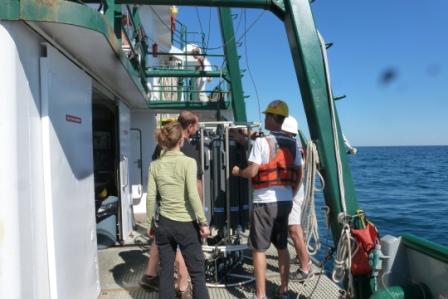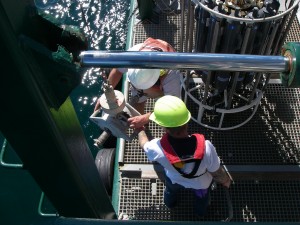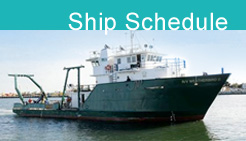Deep Sea Fish and Sediment Surveys in the Gulf
Through the Eyes of Teacher Matt…the day continues
The first Sampling Stations
The Weatherbird II reached its first sampling stations west of Tampa Bay. They were relatively shallow water depths where we collected water and sediments for other researchers who requested offshore samples. It also acted as a great training session for me and the other “greenhorns” on the vessel to get a grasp of how to deploy and retrieve the equipment. At these stations we lowered the rosette of Niskin bottles with the CTD and instrument package in a cradle below the bottles. This array of instruments is operated via an electronics cable attached to a computer on the ship that gives the scientists a real time profile of the water column as they slowly lower it down. The water column data profiled conductivity, temperature and depth (CTD), as well as fluorescence of the water.
Ready to deploy Niskin bottles to collect seawater samples at discrete depths. They lower the rosette of bottles to the bottom; and as they hoist it back toward the surface they start activating the sampling bottles. Each Niskin bottle closes and traps water from different depths/layers. When brought to the surface they pull water from each sample for a variety of purposes. Scientists on the ship are set up in the lab and ready to go when these samples arrive at the surface. One of the most tedious processes I observed at these first locations was the filtering of the water for further analysis. On a separate cable they sent down a heavy Shipek sediment sampler. This is what I would call a bottom grab sampler.
Before sending it down they have to cock it in the open position. It is spring loaded with a really heavy spring. When it hits bottom, it fires, like a bear trap, scooping up about a gallon of sediment from the bottom.
This morning, I suppose because these stations were so close to shore, the bottom was still very firm and mostly sandy at the first station, and eventually became silty the further out we went. We also deployed the multi corer and couldn’t get it to go into the firm sand; despite adding more weight. The multi corer is a large, heavy, round apparatus with an array of clear tubes that are also “set” to close when they are embedded into the bottom and pulled up. They look like they pull up approximately 2 feet of the bottom.
| Print article | This entry was posted by greely on February 7, 2013 at 10:23 pm, and is filed under Oceanic Updates. Follow any responses to this post through RSS 2.0. You can leave a response or trackback from your own site. |




